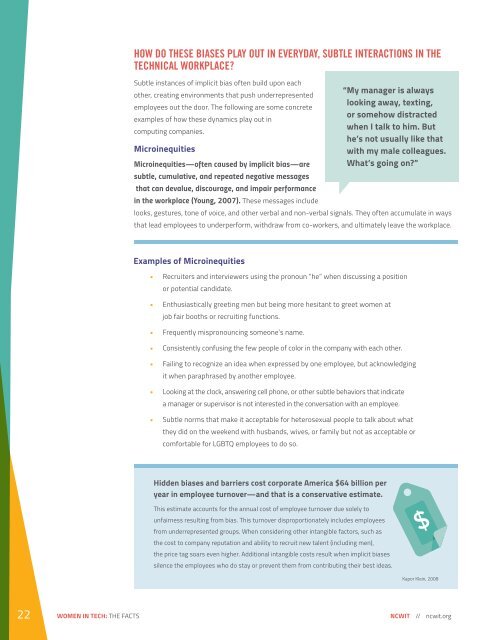WOMEN IN TECH THE FACTS
womenintech_facts_fullreport_05132016
womenintech_facts_fullreport_05132016
You also want an ePaper? Increase the reach of your titles
YUMPU automatically turns print PDFs into web optimized ePapers that Google loves.
HOW DO <strong>THE</strong>SE BIASES PLAY OUT <strong>IN</strong> EVERYDAY, SUBTLE <strong>IN</strong>TERACTIONS <strong>IN</strong> <strong>THE</strong><br />
<strong>TECH</strong>NICAL WORKPLACE?<br />
Subtle instances of implicit bias often build upon each<br />
other, creating environments that push underrepresented<br />
employees out the door. The following are some concrete<br />
examples of how these dynamics play out in<br />
computing companies.<br />
Microinequities<br />
“My manager is always<br />
looking away, texting,<br />
or somehow distracted<br />
when I talk to him. But<br />
he’s not usually like that<br />
with my male colleagues.<br />
What’s going on?”<br />
Microinequities—often caused by implicit bias—are<br />
subtle, cumulative, and repeated negative messages<br />
that can devalue, discourage, and impair performance<br />
in the workplace (Young, 2007). These messages include<br />
looks, gestures, tone of voice, and other verbal and non-verbal signals. They often accumulate in ways<br />
that lead employees to underperform, withdraw from co-workers, and ultimately leave the workplace.<br />
Examples of Microinequities<br />
• Recruiters and interviewers using the pronoun “he” when discussing a position<br />
or potential candidate.<br />
• Enthusiastically greeting men but being more hesitant to greet women at<br />
job fair booths or recruiting functions.<br />
• Frequently mispronouncing someone’s name.<br />
• Consistently confusing the few people of color in the company with each other.<br />
• Failing to recognize an idea when expressed by one employee, but acknowledging<br />
it when paraphrased by another employee.<br />
• Looking at the clock, answering cell phone, or other subtle behaviors that indicate<br />
a manager or supervisor is not interested in the conversation with an employee.<br />
• Subtle norms that make it acceptable for heterosexual people to talk about what<br />
they did on the weekend with husbands, wives, or family but not as acceptable or<br />
comfortable for LGBTQ employees to do so.<br />
Hidden biases and barriers cost corporate America $64 billion per<br />
year in employee turnover—and that is a conservative estimate.<br />
This estimate accounts for the annual cost of employee turnover due solely to<br />
unfairness resulting from bias. This turnover disproportionately includes employees<br />
from underrepresented groups. When considering other intangible factors, such as<br />
the cost to company reputation and ability to recruit new talent (including men),<br />
the price tag soars even higher. Additional intangible costs result when implicit biases<br />
silence the employees who do stay or prevent them from contributing their best ideas.<br />
Kapor Klein, 2008<br />
22 <strong>WOMEN</strong> <strong>IN</strong> <strong>TECH</strong>: <strong>THE</strong> <strong>FACTS</strong> NCWIT // ncwit.org


